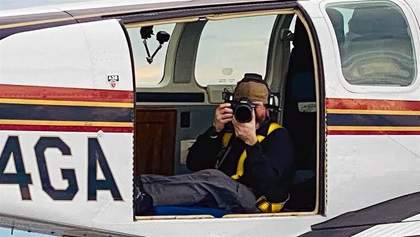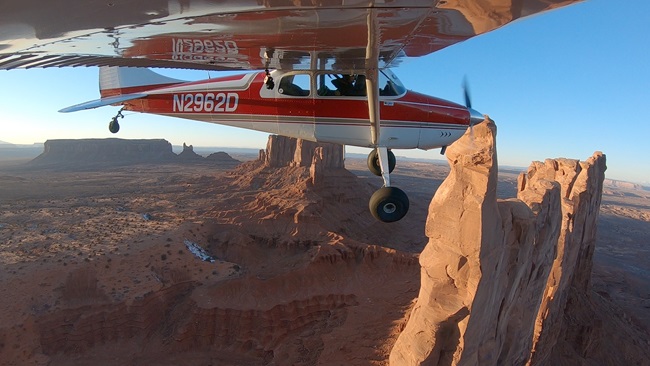It takes teamwork
Lessons learned in pursuit of unforgettable aerial images

Most general aviation flying emphasizes the pilot in command’s independence and autonomy—but photo flights are different. They’re a team sport. Each participant has a unique role and responsibility, and the team succeeds or fails together.
Weather, airplanes, photo and video gear, people, and schedules present countless variables that all must align for a photo flight to produce the desired result. And considering all of the things that can prevent photo flights from happening, it’s remarkable how often they do work. AOPA Pilot has published more than 700 magazine issues in the last 62 years, and that adds up to lots of cover shots, spreads, portraits, and detail photos. Throw in hundreds more issues of Flight Training and weekly editions of AOPA Live and you begin to understand our insatiable appetite for more and better aviation images.
AOPA Senior Photographers Mike Fizer and Chris Rose, as well as editors Mike Collins and David Tulis who are photojournalists, have logged as much time aloft with their cameras over the decades as many professional pilots have at their flight controls. Along the way, they’ve become masters at creating memorable images of airplanes in flight (see “A Moment in Time,” p. 60). They’ve also had to endure some terrifying moments in which pilots involved in photo flights have lost sight of each other, blundered into bad weather, overstated their own qualifications or aircraft capabilities, or shown off with improvisational maneuvers. AOPA’s approach to photo flights is meant to keep such errors from ever happening again.
The mission
Every photo flight begins with an assignment—typically a magazine story that requires aerial photos. The assignment itself often determines the location where the flight will take place. Then the AOPA writer/editor who dreamed up the story and the photographer assigned to it come up with a plan for photos and video and assemble a team to get that done.
At its simplest, an aerial photography flight requires a photo airplane, photo pilot, and photographer, as well as a subject airplane and subject pilot. A safety pilot is preferred for each airplane, too.
Air-t0-air photography




More complex photo shoots involve multiple and sometimes dissimilar airplanes with various speed ranges. We also occasionally produce “Fly-Offs”—head-to-head performance contests between rival airplanes that are especially intricate. But the roles and responsibilities of each participant in AOPA photo flights are the same.
Photographer. The photographer/videographer is an artist—and their objective is to get the best possible images. They direct pilots clearly and unambiguously to get the shots they want.
Photo pilot. The photo pilot leads the flight and handles communications and navigation for the entire formation. The photo pilot keeps the flight clear of terrain and restricted airspace (or obtains clearances for the airspace). The photo pilot must know the limitations of each aircraft, then plan and execute the flight without exceeding them. For example, if the subject airplane is a warbird or a jet with a high stall speed, the photo pilot must maintain a safe airspeed for the subject airplane.
The photo pilot also looks ahead to scout out potential backgrounds and lighting conditions. (The photographer is often facing backward and can’t see ahead of the airplane.)
Subject pilot. The subject pilot maintains sight of the photo airplane at all times; complies with the photographer’s directions, unless doing so compromises safety; and avoids becoming a collision hazard. Subject pilots must decline any directions from the photographer they aren’t sure they can perform safely. If a subject pilot loses sight of the photo airplane, the subject pilot must immediately confess and state their altitude and heading. The photo pilot will resolve the conflict and then decide whether to terminate the flight.
Since the photographer must concentrate on creating images, flight safety is up to the pilots. A subject pilot who declines to perform a requested maneuver isn’t questioned or criticized. The photographer simply moves on to the next task.
Safety pilot. Safety pilots call out traffic, terrain, birds, or other obstacles during flight; monitor airspace; read checklists; and relay directions from the photographer to the subject pilot via radio. Safety pilots have prevented many embarrassing and potentially dangerous mistakes over the years and are valued team members.
A safety pilot in the subject airplane has one additional task—and that’s to smile and look happy. That’s not easy to do when flying close to another airplane and squinting into the sun, but we’ve ruined lots of otherwise excellent photos with frowny faces.
Photo and subject pilots must be well versed and proficient at formation flying. Formation skills have been fundamental for generations of military pilots, and civilian pilots can gain many of the basic concepts and skills through type clubs and formation training organizations such as Formation and Safety Team (FAST) and Formation Flying Inc. (FFI).
But photo flying requires more than simply flying next to another airplane and holding position. Photographers typically want subject airplanes stacked uncomfortably high or low to give viewers angles they can’t see on the ground. They want their subjects turning so images are dynamic, and they often require subject pilots to cycle the landing gear and flaps.
The photo pilot typically flies the lead position, but it can be helpful to change leads during flight to give the photographer another perspective. That’s particularly true when approaching an airport for landing because the photographer can shoot the subject airplane from the rear quarter as it nears the runway—images that are useful in stories about both airplanes and destinations.
Video is becoming a bigger consideration than ever in AOPA photo flights, and it has different requirements than still photos. Still photos should have as little relative movement as possible, and video is all about moving across the screen.
With this in mind, we’ve sought to define and standardize a series of regular video maneuvers. A breakaway, for example, gives a sense of the subject airplane’s roll and turn rates. The photographer commands a breakaway and the subject pilot uses full aileron deflection and starts a level turn away from the photo airplane.
The next maneuver is a rejoin with an underrun. The subject pilot rejoins the photo airplane on the inside of a turn but intentionally passes beneath it and stabilizes on the outside. This creates a dramatic image of the subject airplane growing in the frame as it gets closer to the camera, then passing below.
The videographer then focuses on the vacant piece of sky next to him and calls for the subject pilot to “fill the frame.” A simple cross-under to the normal formation position does the trick.
Photo flights typically last about 90 minutes from takeoff to touchdown, and while that doesn’t sound like a long time, it can be intense, action-packed, and exhausting. There’s a lot riding on the outcome, and the best lighting conditions can be fleeting, if they happen at all.
But there’s a great sense of satisfaction when everything goes as planned and the results are in the bag.
And since the subject pilots get the glory of being on the cover of the Rolling Stone when it’s all over, they buy the beer that night.
Email [email protected]
Getting the shot








